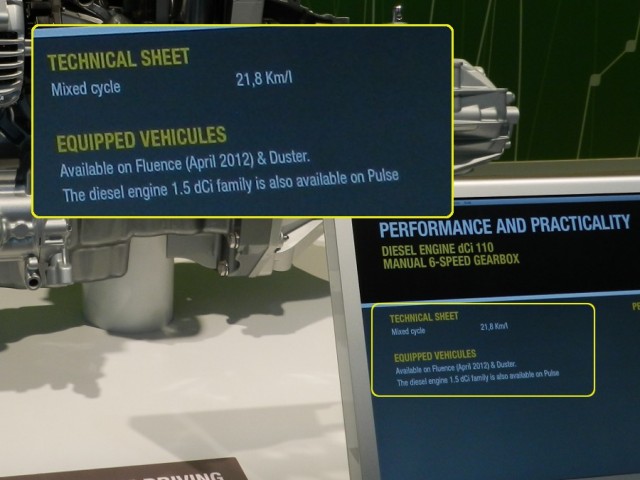What’s all the fuss about? Some of the online media entities also went to the extent of having the usual ‘speculation’ post the day before about what Renault was going to unveil today! The fact that the slightly newer dCi 110 engine was going to shove out the older engine in the Fluence’s bay was revealed at the Auto Expo when Renault had the dCi 110 engine on display alongside the Formula 1 RS27 engine.
Contrary to what you may have read elsewhere, the claimed fuel efficiency figures seem to have remained unchanged. The ARAI fuel efficiency of 20.4 kpl being advertised by Renault now is probably the equivalent ‘Mixed Cycle’ fuel efficiency of 21.8 kpl that was the figure mentioned previously with the 106 PS engine. We shall wait for Renault to clear our doubts.
So where does the new variable geometry turbo with simplified air intake path show its prowess? Better driveability, and the marginal increase in horsepower, without loss of fuel efficiency, with lowered emissions, that’s where. This ought to make urban commuting much easier for prospective customers, but we will hold our opinions until we do a comprehensive review.
The features list remains unchanged and you get decent bang for your buck with a host of features including ABS, EBD, brake assist, ASR and also ESP along with front and side airbags for the drivers and the passenger riding shotgun. Other features include rain sensing wipers, automatic headlamp on feature, ICE with USB, AUX and Bluetooth connectivity, engine stop/start button, cruise control and rear parking sensors.
Now, although we do love the welcome change in the form of better driveability there’s a reason we sound not so enthusiastic. In January 2012, the Renault Mégane family which was powered also by the dCi 110 engine got the Energy dCi 110 powerplant. This engine makes 20Nm more torque and as icing on the cake also reports a 12 % increase in fuel efficiency.
Here’s what else you would have got with the new Energy dCi 110
- Stop & Start Tech that would have driven the fuel efficiency upto atleast around 26 kpl ( claimed of course)
- ESM braking/deceleration energy recovery
- EGR low-pressure exhaust gas recirculation
- DLC-coated (Diamond Like Carbon) cam followers ( Renault says that’s Formula 1 tech)
- ANI fuel injection nozzles (with individualised spray cone angle)
Check out this video and tell us you do not want the Energy dCi 110.
There must be economies of scale, customer requirements and more factored into why Renault didn’t skip one generation of dCi 110 engines and jump directly into the ‘Energy Engines’ bandwagon, but we are disappointed nontheless.
So again, what’s all the fuss about?
The to be launched Duster also gets the dCi 110 engine.
